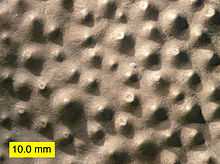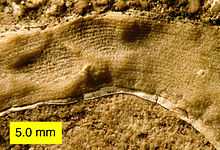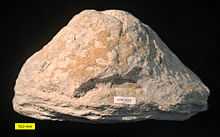Stromatoporoidea
| Stromatoporoidea Temporal range: Cambrian–Cretaceous | |
|---|---|
 | |
| Top view of a stromatoporoid showing mamelons; Columbus Limestone (Devonian) of Ohio. | |
| Scientific classification | |
| Kingdom: | Animalia |
| Phylum: | "Porifera" |
| Class: | †Stromatoporoidea |
| Orders | |
|
See text. | |

Stromatoporoidea is a class of aquatic invertebrates common in the fossil record from the Ordovician through the Devonian. They were especially abundant in the Silurian and Devonian.[1] These invertebrates were important reef-formers throughout the Paleozoic and the Late Mesozoic. The group was previously thought to be related to the corals and placed in the Phylum Cnidaria. They are now classified in the sponges (Phylum Porifera), specifically the sclerosponges. There are numerous fossil forms with spherical, branching or encrusting skeletons of laminated calcite with vertical pillars between the laminae.
Stromatoporoids are useful markers whose form and occurrence can diagnose the depositional environment of sedimentary strata.[2] Paleozoic stromatoporoids hosted various symbiotic endobionts such as rugosans, syringoporids, worms and cornulitids.[3][4]
References
- ↑ Stock, C.W. 2001, Stromatoporoidea, 1926–2000: Journal of Paleontology, v. 75, p. 1079–1089.
- ↑ Da Silva, A. C.; Kershaw, S.; Boulvain, F. (2011). "Stromatoporoid palaeoecology in the Frasnian (Upper Devonian) Belgian platform, and its applications in interpretation of carbonate platform environments". Palaeontology: 1–23. doi:10.1111/j.1475-4983.2011.01037.x.
- ↑ Vinn, O; Mõtus, M.-A. (2014). "Endobiotic Rugosan Symbionts in Stromatoporoids from the Sheinwoodian (Silurian) of Baltica". PLoS ONE: 9(2): e90197. doi:10.1371/journal.pone.0090197. Retrieved 2014-02-26.
- ↑ Vinn, O.; Wilson, M.A.; Mõtus, M.-A. (2014). "Symbiotic endobiont biofacies in the Silurian of Baltica". Palaeogeography, Palaeoclimatology, Palaeoecology 404: 24–29. doi:10.1016/j.palaeo.2014.03.041. Retrieved 2014-06-11.
